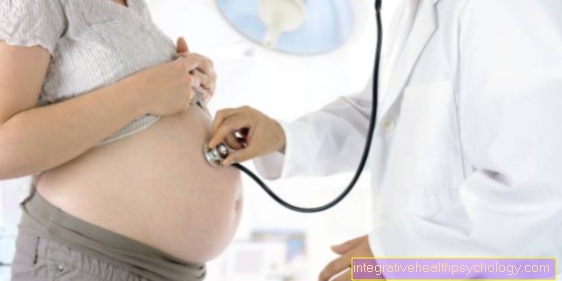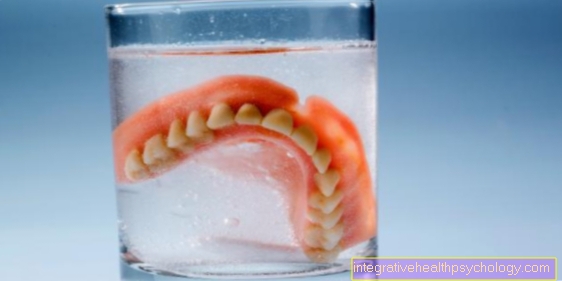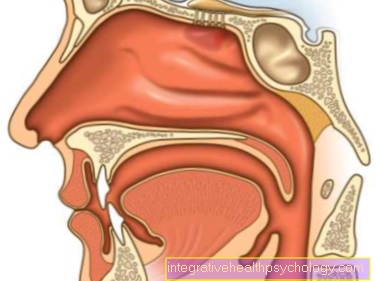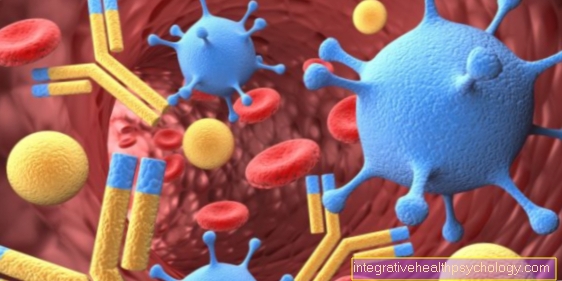What is a gestosis?
Synonyms
Preeclampsia, eclampsia, HELLP syndrome, pregnancy poisoning
definition
Gestoses are pregnancy-associated diseases that are based on general cramping of small arteries. Psychological factors such as a disturbed relationship with one's own mother and magnesium deficiency are also discussed as causes. Symptoms are high blood pressure (hypertension), water retention in the tissues (edema), excessive reflexes and the excretion of proteins in the urine (proteinuria).

Depending on the severity, sedatives (Sedatives), Antihypertensive drugs (Antihypertensive drugs), a diet and relaxation procedures for commitment come. Sometimes, however, a delivery is unavoidable.
After the birth there is usually complete healing. However, the likelihood of falling ill again during pregnancy is higher than that of the normal population.
The high blood pressure (hypertension) in the context of a gestosis is defined by measuring a blood pressure of over 140/90 mmHg twice at intervals of several hours. If protein excretion also occurs in the urine, this is referred to as Pre-eclampsia.
Read more on the topic: Pregnancy hypertension
What are the signs?
Signs of a gestosis can be of various types, since a gestosis does not have to be limited to a specific organ, but can generally affect various organs.
For example, a gestosis can affect the kidneys. Symptoms of this are characterized by a reduction in the total amount of urine produced daily (oligouria). Signs of this are less frequent urination or less urine when using the toilet. Another symptom of kidney involvement is water retention in various parts of the body (edema), often the legs. Proteins can also be detected in the urine using a special test strip (proteinuria).
If the lungs are involved, shortness of breath / shortness of breath can be another symptom. This is often caused by water retention in the lungs (pulmonary edema). Particular attention should be paid to the involvement of the liver and the central nervous system. Possible liver involvement can be represented by right-sided pain in the upper abdomen (pain below the right costal arch). Seizures, sensitivity to light and noise, as well as headaches, nausea and vomiting can be symptoms of involvement of the central nervous system.
Edema
Edema is fluid retention in the tissue. Gestosis can lead to edema in various parts of the body (often feet, legs). On the one hand, edema can occur as a result of reduced fluid excretion by the kidneys. This increases the fluid in the blood vessels. This builds up and is pressed into the fabric by the pressure caused by the congestion. If you press on the fluid-swollen tissue and a dent remains, which only slowly recedes (after several seconds to minutes), this is a relatively sure sign of edema.
In rare cases, fluid retention in the lungs can also lead to shortness of breath. Here the heart can no longer pump the increased volume of fluid into the body's circulation. As a result, the fluid backs up in the lungs and is pressed into the lung tissue due to pressure.
Read more on this topic: Edema in pregnancy
high blood pressure
One differentiates here on the one hand the pregnancy-induced increase in blood pressure (hypertension). This means an increase in blood pressure of over 140/90 mmHg (or severe hypertension with a 2nd value (diastolic) of more than 110 mmHg) which occurs after the 20th week of pregnancy (SSW). Normal blood pressures (less than 140/90 mmHg) should have been measured before and during pregnancy (up to the 20th week of pregnancy).
A distinction must be made between this and the pregnancy-independent increase in blood pressure. This means a known, long-standing increase in blood pressure, as well as the increase in blood pressure before the 20th week of pregnancy (limit values see above). Since high blood pressure increases the risk of so-called preeclampsia, special attention should be paid to the protein excretion in the urine when the blood pressure is increased. This means that complications such as eclampsia or HELLP syndrome can be prevented or recognized at an early stage.
Protein in the urine
The kidneys can only cope with the increased blood pressure to a limited extent, so that over time substances such as proteins, which are normally held in the blood by a filter (blood-urinary barrier), get into the urine due to the increased pressure. In technical jargon, when there is increased excretion of protein in the urine, one speaks of proteinuria. This can be determined using test strips in every doctor's office. Alternatively, a more detailed urine diagnosis can be carried out. For this purpose, mid-stream urine is used or, in some cases, bulk urine (urine collected over 24 hours).
Also read: Protein in the urine during pregnancy
Symptoms
Gestoses are many different pregnancy-associated diseases, which therefore also lead to many different symptoms. A distinction is made between early gestosis and late gestosis.
The early gestosis that occur in the first trimester of pregnancy includes nausea with moderate vomiting (emesis gravidarum) or with an insatiable vomiting (hyperemesis gravidarum). This can occur throughout the day or at night. Vomiting can lead to dehydration (desiccosis) and severe weight loss, rapid heartbeat and low blood pressure. Electrolyte disturbances and their consequences as well as fever, drowsiness and a worsening of the general condition can occur. Sickness in pregnancy is caused by the increased beta-HCG level, which increases steadily up to the 12th week of pregnancy and then decreases again, so in most cases the symptoms are expected to subside after the 12th week of pregnancy.
The increased salivation (Ptyalism, hypersalivation) represents an early gestosis. It can occur alone or in connection with nausea and vomiting and can make the nausea even more uncomfortable.
The late gestoses that can occur in the last trimester of pregnancy include preclampsia, eclampsia and HELLP syndrome.
In preclampsia, patients often suffer from dizziness, headaches, visual disturbances, flickering eyes, nausea, vomiting, water retention (Edema) and drowsiness. The water retention is usually noticed by the pregnant woman through a relatively sudden weight gain (> 1 kg per week). These symptoms are caused by the high blood pressure (> 140/90 mmHg) and the loss of protein in the urine (Proteinuria).
In eclampsia, in addition to the above Symptoms of preclampsia, to seizures with or without loss of consciousness. Before such an attack, severe headaches (often in the forehead area), eye flickering, double vision, general malaise, neurological deficits, nausea and vomiting can occur. Eclampsia is a threat to mother and child due to possible complications (kidney failure, defective function of the placenta (placental insufficiency), brain swelling (cerebral edema), retinal damage, thrombosis and bleeding).
Read more on the topic: Epileptical attack
In the case of HELLP syndrome, which also belongs to the high blood pressure disorders in late pregnancy (but can also occur without increased blood pressure and protein loss) and represents a severe form of preclampsia, the patients suffer in addition to the above. Symptoms of preclampsia include extreme pain in the upper right abdomen and possibly nausea, vomiting and diarrhea. The pain is caused by overstretching the liver capsule. The symptoms can appear within a very short time (1 hour), although some patients have a sudden high blood pressure beforehand. Compared to simple preclampsia, the complications of HELLP syndrome are more frequent, more diverse and more serious.
Usually the symptoms of late gestosis disappear again a few days after the birth at the latest, whereby an eclamptic attack is also possible in the puerperium.
Read more on the topic: Poisoning during pregnancy
causes
The causes of a gestosis are not clearly understood. Various causes are discussed in specialist committees. On the one hand, hormonal changes during pregnancy can lead to the development of a gestosis. The change in the immune system can also contribute to the development. A genetic link is also taken into account. Often, however, it is an interplay of all these factors and possibly also other factors (not yet known at the moment) that lead to the development of a gestosis.
How dangerous can that be?
In the worst cases of gestosis, eclampsia or a so-called HELLP syndrome can develop. Eclampsia is countersigned by preeclampsia (pregnancy-induced increase in blood pressure and increased protein excretion) and the simultaneous occurrence of seizures. At the beginning, patients usually have headaches, visual disturbances, nausea and vomiting.
Since seizures endanger the health of the unborn child and mother, one should prevent seizures with medication, especially if there are signs of pre-eclapmsia.
The second major complication of gestosis is HELLP syndrome. This is where small blood clots appear, which clog the smallest blood vessels in the body. There is also a breakdown of red blood cells and a decrease in the number of platelets caused by the clots. As a result, liver damage occurs. A HELLP syndrome often occurs with upper abdominal pain and relatively unspecific symptoms such as nausea, vomiting and diarrhea.
Since HELLP syndrome as well as eclampsia can lead to life-threatening complications in mother and child, drug therapy and immediate delivery of the child are essential.
Duration and forecast
The cause of the gestosis is the pregnancy-related increase in blood pressure. This means that only the termination of pregnancy (e.g. childbirth, caesarean section) can completely cure a gestosis (causal therapy). Otherwise, the gestosis is treated with general measures such as stress reduction or drug therapy that tries to prevent the progression of a gestosis or reduces the risk of preeclampsia, eclampsia or HELLP syndrome. Therefore one can say that the duration of a gestosis corresponds to the duration of pregnancy.
Can you prevent a gestosis?
The best prevention of a gestosis is a regular prenatal check-up. There, attention is paid to signs of a gestosis and treatment can be started early to reduce the risk of complications.
If preeclampsia had occurred in a previous pregnancy, the gynecologist can recommend therapy with acetylsalicylic acid (ASA) up to the 36th week of pregnancy to prevent the patient from recurring. If the patient has already had a seizure during pregnancy or if a seizure is considered likely to occur, the patient should be treated with magnesium sulfate.
Read more on this topic: Pregnancy check-up
Blood test
In addition to urine tests, blood pressure measurements and ultrasound examinations, the blood test is an important diagnostic tool for detecting a gestosis.
In preclampsia, proteins in the blood are low, as these are excreted more by the kidneys (proteinuria). Due to the reduced protein concentration in the blood, the blood water flows through osmolar forces into the surrounding connective tissue and is therefore absent from the blood. In relative terms, this increases the proportion of blood cells (hematocrit) and the proportion of carrier proteins for oxygen in red blood cells (hemoglobin) on whole blood.
Eclampsia has increased levels of blood cells (Hematocrit) and the proportion of carrier proteins for oxygen in red blood cells (hemoglobin) on the whole blood; in addition, reduced kidney activity can increase the body's degradation substances that are excreted via the kidneys (uric acid, creatinine and urea).
Three important blood parameter areas play a decisive role in the detection of a HELLP syndrome:
- First, the number of blood platelets is low (thrombocytopenia).
- Second, the blood shows signs of red blood cell breakdown (Hemolysis). Signs of haemolysis are a reduced value of a transport protein (Haptoglobin) for the carrier of oxygen in red blood cells (Hemoglobin in red blood cells), a lowered level of an enzyme (LDH) found in all cells, an increased level of a breakdown product of red blood cells (bilirubin), a lowered level of the proportion of blood cells in the whole blood (Hematocrit) and a decreased level of the carrier protein for oxygen in red blood cells (hemoglobin).
- Thirdly, in a HELLP syndrome, important liver enzymes (transaminases) such as GOT, GPT increased.
- In addition, blood coagulation values such as fibrinogen (an important coagulation factor) and antithrombin III are decreased, and fibrinogen breakdown products are increased.
Diet in a gestosis
The diet during gestosis does not differ significantly from the dietary recommendations for a pregnancy without complications. You should make sure to consume enough protein (100g per day through e.g. milk, buttermilk, cheese, legumes, nuts). Minerals such as vitamins B1, B2, E (e.g. contained in bread, potatoes, rice, pasta) as well as vitamins C and E absorbed through fruit and vegetables are important. When consuming fish, meat and eggs for protein intake, the correct type and preparation must always be observed (ATTENTION: possible risk of infection with bacteria, parasites). In addition, a pregnant woman should drink around 2 to 2.5 liters of fluid per day.
pre-eclampsia
This affects around 1 in 20 pregnant women. An increased risk for the development of this clinical picture are among others a first pregnancy and a genetic predisposition. Also chronic diseases like diabetes are among the risk factors as they can lead to changes in the blood vessels. The exact origin is unclear, but the development of the mother cake (placenta) a major role. If the vessels are not formed correctly and the fruit does not get enough blood as a result, the maternal blood pressure rises to compensate for this in order to try to ensure adequate blood flow. Nevertheless there are more and more premature births (p. Premature birth), lack of development and even death of the fruit.
Edema and bleeding can occur in many places in the mother's body. Edema in atypical areas such as the hands and face is a warning sign. In severe cases, neurological symptoms such as visual disturbances, a headache, Nausea and an increase in reflexes occur.
You might also be interested in: pre-eclampsia
If the clinical picture worsens, one speaks of:
HELLP syndrome
The HELLP syndrome (haemolysis, elevated liver enzymes, low platelets) is primarily caused by liver damage with an increase in liver enzymes and a decrease in the number of blood platelets (Platelets) is a life-threatening disease (S. Leber). The pregnant woman suffers from a general feeling of illness, nausea and neurological symptoms (see above). Pain in the right upper abdomen is a special warning sign.
Depending on the severity of preeclampsia and the time of pregnancy, it may be necessary to terminate it immediately. To do this, however, the pregnant woman should be in a physically stable condition to be able to cope with childbirth and, if possible, have reached the 37th week of pregnancy in order to give the fetus (unborn child) enough time to mature.
If the course is easier, diet, physical restraint and the administration of blood pressure-lowering medication under inpatient supervision can help. If the course is more severe, sedatives (Sedatives) and magnesium sulfate to keep the condition stable and delay childbirth.
In the case of HELLP syndrome, on the other hand, induction of labor is necessary in order not to endanger the mother's life.
You can find out more on our HELLP Syndrome page.
Eclampsia
Eclampsia either results from preeclampsia or occurs unsigned. Symptoms only arise in a quarter of cases after birth. These are so-called tonic-clonic seizuresas they are also under a epilepsy may occur. In dramatic cases, the pregnant woman can also fall into a coma. In general, intensive medical monitoring and the administration of sedatives and magnesium necessary.
Chronic hypertension
Existed before pregnancy high blood pressureIf it occurred before the 20th week of pregnancy or if it persists for more than 6 weeks after the birth, this is called chronic hypertension. Usually the symptoms of preeclampsia (see above) are absent, but occur Protein excretion in the urine and Edema in addition, one speaks of a so-called grafted preeclampsia. This then carries the same risks as a separate preeclampsia. In the case of lighter forms, it is advisable to relax and refrain from nicotine and alcohol. If the blood pressure values are higher, they must antihypertensive drugs are used.





























